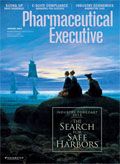Product Liability Claims and Comment K
Courts across the country are making it easier to prove that a drug is unsafe, warning label notwithstanding.
Consider the following hypothetical: After three weeks of listening to the evidence, eight jurors—none of whom have taken a science class beyond high school chemistry—are sent back to a jury room in a state court courthouse to determine whether the plaintiff and her lawyer have successfully proven that your prescription drug was defectively designed, simply because the plaintiff's injury outweighed the benefits that caused her to take your blockbuster FDA approved medication in the first place.

Andrew Solow
Unless the recent shift in product liability law reverses course, this scene might repeat itself around the country with you on the receiving end of this update from your trial counsel. In the past, prescription drug manufacturers (and by extension, medical device manufacturers) have been able to limit common-law product liability lawsuits to claims that defendant's warnings were inadequate. Recently, however, trial and appellate courts around the country have begun empowering juries (and plaintiffs' lawyers) to decide whether or not a prescription drug is defectively designed. It is critical, therefore, that pharmaceutical companies and their counsel embark on a coordinated effort to educate the judiciary about the social consequences of giving juries (or courts) the responsibility of determining a prescription drug's therapeutic value.

Daniel Meyers
Background
Until recently, the overwhelming state of the law was that a pharmaceutical company facing litigation based on the sale of a prescription drug was able to rely on two legal doctrines to generally limit a plaintiff's claims to proving that a defendant's warnings were inadequate. First, almost every state applies the "learned intermediary" doctrine, which obviates pharmaceutical companies' need to directly warn consumers, and allows pharmaceutical companies to avoid liability provided they adequately warn the plaintiff's prescribing physician. Second—and the focus of this article—is "Comment K" of the Restatement (Second) of Torts, which effectively barred strict liability design defect claims against pharmaceutical companies. Comment K states that some products are "unavoidably unsafe" and therefore are neither defective nor unreasonably dangerous provided they are properly prepared and accompanied by adequate warnings.
Based on these two legal doctrines, claims against pharmaceutical companies were, for the most part, limited to a negligence standard (or a strict liability-in-name-only standard) that required a jury to weigh the adequacy of the warnings either in light of the company's duty of care, or in other words, what the company knew or should have known (negligent failure to warn theory), or the state of the science at the time the product was sold (strict liability failure to warn theory). Such standards avoided the harsher impact of a strict liability claim faced by non-prescription products like automobiles, chainsaws, and hot-water heaters. The rationale for this was that prescription drugs are useful and desirable for society even though they are incapable of being made safe for their intended and ordinary use without proper warnings. Based on this strong public policy, strict liability claims against prescription drugs were generally limited to a much harder burden of proving a safer and feasible alternative design.
Shift in the law
A recent trend in the law has greatly weakened the impact of Comment K and shifted the focus away from pharmaceutical companies' warning labels. In more and more jurisdictions, plaintiffs are now able to prove liability by the more liberal and jury-friendly strict liability standards previously applied to non-prescription products. Under these traditional strict liability standards, the jury is allowed to determine whether a product is defectively designed under a risk-utility test—whether a product's risks outweigh the intended benefits, a decision ostensibly made already by regulators—or even worse, a consumer-expectation test which, in essence, asks the jury to determine if a consumer would have expected to be injured by the product in the manner in which she was injured.
In some of these jurisdictions, Comment K has been reduced to an affirmative defense which only offers a defendant a Hobson's Choice of either defending the product under the more liberal and jury-friendly strict liability standards or taking on the affirmative burden of first convincing the jury that its prescription drug is "unavoidably unsafe" in order to rely on its warning label as an affirmative defense (i.e. that the drug was labeled adequately despite the risks outweighing the benefits). No pharmaceutical company can be pleased with the proposition of having its media relations team explaining why its trial lawyer just stated in open court that its most successful medication on the market is "unavoidably unsafe."
How to fix the problem
First, in jurisdictions where the appellate courts have not already shifted the law to this more liberal approach, the best chance to convince a trial judge to follow the original interpretation of Comment K, which focused on the company's prescription drug's warnings, may be to revisit and update the public policy arguments that first formed the basis of Comment K. Pharmaceutical companies and their counsel should draw the court's attention to the repercussions of permitting a jury to declare a drug—which is FDA-approved as "safe and effective" and still on the market—categorically defective based on the jury's determination that the drug's risks outweigh the benefits for a particular plaintiff. A jury should not be empowered to cast aside the rigorous drug approval process, which requires years of research and development, clinical trials, and FDA approval before a drug can enter the market.
Courts should also be focused on the practical implications of the jury's task. For example, is a jury to weigh the entire range of the medication's therapeutic values or simply find that a drug is defective for the plaintiff's prescribed dosage and duration given the symptoms she was prescribed the drug to treat? If the latter, how can a drug be declared "defectively designed," even though the same jury may have decided that the drug was not defective if it was prescribed in a lower dosage, for a shorter duration, or to treat a different symptom? Likewise, how does a determination of "defective design" account for the thousands (or millions) of users who benefit from the drug without any adverse side effect? Such an inquiry demonstrates why prescription medications must be judged on their warnings, which account for proper dosage and usage. After all, warning labels can be revised and updated as science evolves, but a "defectively designed" drug cannot be reformulated without spending untold millions of dollars on research and development.
Second, pharmaceutical companies and their attorneys should alert the court that this shift in product liability law creates the potential for inconsistent verdicts and irrational judicial outcomes. As one Connecticut federal court judge recognized earlier this year in Moss v. Wyeth Inc., there is a risk of inconsistent verdicts because the "defendant's burden to prove the adequacy of the warning [in a strict liability design defect claim] is the mirror image of the plaintiff's burden to prove the inadequacy of the warning in a warning defect claim." Similarly, Bartlett v. Mutual Pharm. Co., a case from the First Circuit—the appellate court for federal trial courts in Maine, Massachusetts, New Hampshire, Puerto Rico, and Rhode Island—teaches us that the new trend can result in a situation where the court dismisses a failure to warn claim, yet a jury (or court) finds the defendant strictly liable for selling a defective product. Both of these outcomes are avoided by focusing litigation on a prescription drug's warnings.
Finally, pharmaceutical companies and their counsel must engage in a strategic, big picture approach in the appellate courts. As the old adage goes, "bad facts make bad law." As such, one must carefully weigh the desire to appeal any adverse ruling with the need to appeal the "right" adverse ruling. Simply put, pharmaceutical companies do not want the wrong case to end up in front of appellate courts—or even worse, the United States Supreme Court. With this in mind, pharmaceutical companies should work with their counsel to select at least one strong case to get on an appellate court's docket for 2013. Convincing one appellate court to adhere to what may now be the minority's interpretation of Comment K could be all it takes to shift the current tide in product liability law.
Andrew Solow is a Partner at Kaye Scholer LLP. He can be reached at Andrew.solow@kayescholer.com
Daniel Meyers is an Associate at Kaye Scholer LLP. He can be reached at Daniel.meyers@kayescholer.com

MDMA Therapy for Mental Health Conditions: Do the Benefits Outweigh the Risks?
October 25th 2024Despite a recent FDA Complete Response Letter issued to Lykos for midomafetamine capsules for the treatment of post-traumatic stress disorder, experts believe that the future is bright for psychedelic drugs that treat mental health conditions.
Securities Litigation Arising from Alzheimer's Drug Treatments
September 25th 2024The legal challenges surrounding Biogen’s Aduhelm and Cassava Sciences’ simufilam underscore the ongoing difficulties in Alzheimer's drug development, leading to securities litigation over allegedly misleading statements about trial results and commercialization efforts.